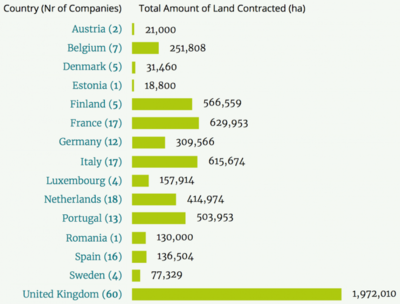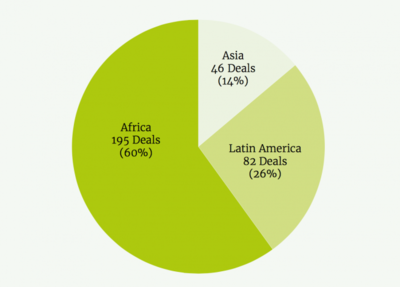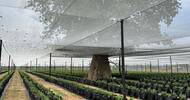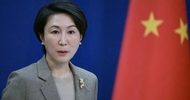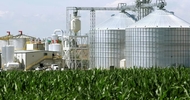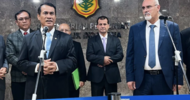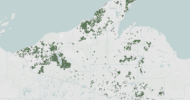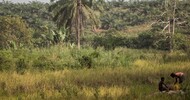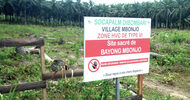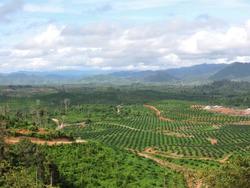
Palm oil plantation on indigenous peoples lands/forests in Myeik District, Tanintharyi Region, Myanmar. / Photo credit J. Franco
Landgrabbing: Contested meanings of land
Across the world, peasants, pastoralists, fishers, and indigenous peoples are losing their once effective control over the land, water, wetlands, pastures, fishing grounds and forests on which they depend including the right to decide how these natural resources will be used, when and by whom, at what scale and for what purposes, often for generations to come.
Sylvia Kay
In collaboration with SDG Watch Europe
This is a chapter first published in the Spotlight Report on Sustainability in Europe by SDG Watch Europe, called 'Who is paying the bill ? (Negative) impacts of EU policies and practices in the world'
You can find the full report here.
You can find the full report here.
This process known as landgrabbing takes place through different mechanisms (concessions, long-term leases, contract farming), involving different actors (public, private, foreign, domestic) and for different reasons (including for agricul- ture, forestry, energy, mining, industry, infrastructure, real estate, tourism, and conservation).1 In this process, existing uses and meanings of land and territories are overridden, shifting from locally adapted, culturally appropriate, mostly small-scale and labour intensive use towards more large-scale, capital-intensive and extractive forms of resource appropriation. The implications of this model of development in terms of human rights, rural livelihoods, food security, and ecology have been well documented.
The role of the European Union (EU) in landgrabbing is manifold. EU actors are involved in the financing of large-scale land deals worldwide. This occurs through forms of private finance (companies, banks, pension funds, hedge funds, brokerage firms, insurance groups), public finance (development finance and other state sponsored projects), and increasingly through a combination of both in the shape of public-private partnerships, multi-stakeholder initiatives, and other forms of blended finance’. Figures 1 and 2 provide an overview of the involvement of EU investors in large-scale land deals in the global South.3
Figure 1. Amount of land directly controlled by EU companies outside of Europe
Figure 2. EU land deals by region
The response by EU policymakers to evidence regarding the involvement of EU investors in landgrabbing has been mixed. On the one hand, official studies have been commissioned, and largely endorsed, by the European Parliament on landgrabbing, both inside and outside Europe.4 The importance of land tenure security (and women’s land rights in particular), free, prior and informed consent (FPIC), and responsible agricultural investment are issues that have all been raised by EU policymakers within the broader framework of a good governance agenda. On the other hand, the tensions between the EU’s trade and investment policy and human rights obligations are often glossed over with an increasing reliance on a code of conduct approach rather than robust mechanisms for accountability and redress. The use of EU development assistance to subsidise private investments in developing countries, including in the area of agriculture, further increases the risk of landgrabbing, especially in the absence of strong due diligence and effective monitoring and accountability mechanisms for affected communities.
EU domestic policies and landgrabbing in the global South
Addressing the challenges posed by landgrabbing involves a critical examination of some of the underlying drivers of landgrabbing. This means not just demanding better land governance in the global South, but also looking at the ways in which, in an interconnected world, the EU’s domestic policies impact on land and territories outside of Europe. This section will focus on the implications for landgrabbing in the global South of four EU domestic policies including: a) the EU’s Common Agricultural Policy; b) the EU’s bioenergy policy; c) the EU’s trade and investment policy; and d) the EUs Green Growth and Blue Growth strategies.
A not so Common Agricultural Policy
As the EU’s flagship agriculture and rural development programme, the Common Agricultural Policy (CAP) is one of the primary influencers of land use and distribution patterns within the EU. Moreover, as an agricultural policy that rewards industrialisation, specialisation and export orientation within a globally competitive trade in foodstuffs and agricultural commodities, it also has a strong impact on land outside of Europe. Much has been said already here about the role of dumping (the flooding of markets with cheap, subsidized exports) as well as the prizing open of national agricultural sectors through the signing of free trade agreements in terms of undercutting the position of farmers and domestic food production in the global South with all the ramifications for land use and distribution patterns that this entails.
What is particularly worth highlighting is how the EU’s position as an agricultural powerhouse is also dependent on the huge import of agricultural commodities and inputs from the global South. Europe has a vast ‘land import dependency’ with nearly 60% of the land used to meet Europe’s demand for agricultural and forestry products coming from outside its borders.5 Within this, the EU’s livestock industry plays an exceptionally large role given that:
- Three quarters of the EU’s consumption of protein-rich feedstuffs currently comes from abroad;
- The EU is by far the world’s largest importer of soymeal and the second largest importer of soybeans after China;
- Several European firms rank among the world’s top feed companies;
- The CAP supports the growth of the European livestock industry not only by subsidising cereals used as animal feed but also with intervention prices, direct payments, export refunds as well as investment aids directed towards industrial-scale animal farms.6
The boom of the EU’s bioeconomy
The boom of the EU’s bioeconomy touches on many interrelated dimensions of the EU’s policies on growth, climate, and energy. At its heart, is a vision of a new economy based on the increasing use of biotechnologies and agrofuels in order to respond to growing concerns about the unsustainable use and management of finite natural resources, especially fossil fuels.8 This involves the conversion, through technical processes, of food and non-food agricultural crops, into sources of bio-based energy, plastics and chemicals, to be used for a variety of agricultural, industrial, transport, waste recycling, and environmental technology purposes.
The EU has invested heavily in the future of the bioeconomy. It has been rolled out through the following measures:
- The adoption in 2009 of the EU’s Renewable Energy Directive (RED)9 which set out an overall goal of generating 20% of energy from renewable sources by 2020 and mandated that 10% of all energy consumed in the transport sector come from renewable sources by 2020.
- The publication in 2015 of a dedicated Bioeconomy Strategy10 by the European Commission to be championed through national bioeconomy action plans developed by individual EU Member States.
- The implementation of a series of support measures including direct subsidies for research; tax-exemptions; support programmes for establishing bio-plants’ (e.g. for biogas, biomass co-generation of heat and power, agrofuels) and for running these plants; a steady flow of research and development funds (e.g. through the EU ALTENER programme or through national programmes); support programmes for the production of raw material for bioenergy in agriculture and forestry (e.g. through EU rural development schemes).
So far, the EU has largely responded to these concerns with non-solutions.12 The inability to examine the real implications of rising agrofuel and bioenergy demand in the EU on land and natural resources in the global South, along with an unwillingness to engage in a deeper conversation on the EU’s model of energy production, ownership, use, and consumption means that a just transition towards a truly sustainable economy is likely to prove elusive. In fact, it is clear that agrofuels will continue to play a dominant role. The EU’s 2050 Energy Strategy13 for example, projects that by 2050, up to 40% of energy consumption in the transport sector (aviation, inland navigation and long-distance road freight) will come from sustainable biofuels'.
Investment and trade policy: a license to grab?
The impacts of the EU’s (inward and outward) investment and trade policy on land in the global South are multifaceted and complex. Critical analysis has focussed on the EU’s role in a global investment regime that through various clauses and mechanisms - grants far-reaching investment protection to (foreign) investors while curtailing, or threatening to curtail, governments’ ability to regulate for progressive public policies.14 Specifically, when it comes to land governance, this regime:
- hinders necessary and important land redistribution and restitution programmes;
- locks in onerous land deals;
- fosters land commodification;
- disempowers local legal resistance;
- impedes the reversal of abuses of illegitimate and unjust land (and water) deals;
- limits the scope of progressive agrarian and agricultural policies that protect small-scale farmers and public health.
Strikingly, following a recent ruling by the European Court of Justice, the EU has decided to abolish intra-EU Bilateral Investment Treaties (BITs), arguing that they are incompatible with the rules of the internal market and crucially, that EU Member States must be allowed to regulate in the public interest.15 This is noteworthy as one of the main criticisms levied against the use of these BITs is that they exert a ‘chilling effect’ on states’ willingness and ability to legislate in the public interest, significantly reducing their room to manoeuvre. Yet in the unveiling of the new Investment Plan for Europe,16 which is set to replace the old system of intra-EU BITs with a ‘more predictable, stable and clear regulatory environment to promote investments’, no mention is made of the ongoing BITs EU investors have signed with countries in the global South. This suggests that countries in the global South will face continued reduced public control over transnational capital, undermining their prospects for agrarian, environmental, economic and social justice.
While a rethink of the global investment protection regime by the EU is urgently needed, this is not the only area of concern. Increasingly, the way in which modern, financial capitalism works is through complex investment webs, involving multiple, cascading relationships between various (visible and less visible) actors. As part of this process of financialisation, increasing use is made of offshore centres, tax havens, and other shareholding arrangements which mask beneficial ownership and encourage a distancing of accountability. The speculative impacts of these processes of financialisation on land and territories are alarming as land and natural resources are increasingly viewed as vehicles for accumulation rather than being part of embedded social, cultural and ecological relations.
The rise in global farmland being bought up by European financial actors such as banks, pension funds, and insurance groups is one such expression of this trend. It also means that distinctions between the impacts of the EU’s internal and external policies are rendered much more nebulous in a global financial system that blurs these differences. This is further the case given the rise, championed also by the EU within its international cooperation and development policy, of blended finance’ which combines official development aid with the larger deployment of financial instruments (loans, guarantees, equity funds, risk-sharing mechanisms) in order to catalyse private sector investment.17
Capital fixes and the rise of the blue and green economies
The increasing financialisation of land and territories pursued within the context of neoliberal globalisation, both within and outside of Europe, is strongly tied to the discourses of green and blue growth. These appear prominently in a variety of EU policies and programmes including most notably the EU’s 2020 Strategy for Growth18 built around support for a green economy’ and a Blue Growth Strategy.19 Green and blue growth strategies are strongly premised on the belief that achieving a better balance between land/marine based natural resources and human economic activities is generally problem-free and that growth, competitiveness and environmental sustainability can go hand-in-hand. It also assumes a large role for industry and says little about the need for more democratic forms of access to and control over natural resources.
The contradictions of this approach are rarely addressed despite the fact that they seek to reconcile competing goals by relying on a series of fixes’ to further capital accumulation. For example, in the Blue Growth strategy this involves:
- A conservation fix which signals concern for climate change by establishing marine protected areas but leaves the oil and gas industries untouched;
- A protein fix which promotes a tran- sition to aquaculture in order to save ocean space but avoids dealing with the problem of decreasing fish stocks and the need for increasing quantities of feed based on capture fish and other ingre- dients including soy, rapeseed, sunflower and wheat
- An energy/extractive fix which positions offshore wind and other renewable’ energy sources at the forefront of new ocean economy but says little about the sources of the raw materials for these re- newables (including rare-earth minerals obtained through mining).20
Contested meanings of land in Myanmar21
In Myanmar today land is being revalued in a dramatic way by powerful economic actors as they try to grab control of land and other natural resources like water, forests, fisheries and the oil and minerals in the soil. This shift toward a singular meaning of land - namely land simply as a factor of production - is being pushed by extractive, exploitative and predatory business practices and unrestrained rent- seeking behaviour by empowered political and economic elites aimed at controlling land, water, mineral, forest and fishery resources and the benefits of their use. This vision is expressed through a range of large investment projects - including jade and copper mining, hydropower dams, deep sea ports, and the creation of multiple ‘special economic zones’. It is also being codified in legislation, such as in the Vacant, Fallow, and Virgin (VFV) Land Law which allows for land that is not currently titled and being used in certain, prescribed ways to be reallocated on the basis that otherwise, this land is a ‘wasted asset’.
What is being lost as a result of all this? What is being lost are the many meanings and uses and relationships around land that fall outside of the narrow boundaries of land as an economic factor. These wider and more socially meaningful meanings of land include: lifestream, history, sacred spirits, homeland, livelihood, sanctuary, safety net, daily life space, sacred places, watershed, inheritance, life with dignity, and last but not least, gift from Nature. As a farmer from Shan State expresses: “Land is our life as well as our prestige. It’s the food for us to survive, the home for us to live, and the place of unity for our family. Also land is our precious inheritance throughout the generations.” The burning question now standing before Myanmar is whose vision of development will ultimately count?
In Myanmar today land is being revalued in a dramatic way by powerful economic actors as they try to grab control of land and other natural resources like water, forests, fisheries and the oil and minerals in the soil. This shift toward a singular meaning of land - namely land simply as a factor of production - is being pushed by extractive, exploitative and predatory business practices and unrestrained rent- seeking behaviour by empowered political and economic elites aimed at controlling land, water, mineral, forest and fishery resources and the benefits of their use. This vision is expressed through a range of large investment projects - including jade and copper mining, hydropower dams, deep sea ports, and the creation of multiple ‘special economic zones’. It is also being codified in legislation, such as in the Vacant, Fallow, and Virgin (VFV) Land Law which allows for land that is not currently titled and being used in certain, prescribed ways to be reallocated on the basis that otherwise, this land is a ‘wasted asset’.
What is being lost as a result of all this? What is being lost are the many meanings and uses and relationships around land that fall outside of the narrow boundaries of land as an economic factor. These wider and more socially meaningful meanings of land include: lifestream, history, sacred spirits, homeland, livelihood, sanctuary, safety net, daily life space, sacred places, watershed, inheritance, life with dignity, and last but not least, gift from Nature. As a farmer from Shan State expresses: “Land is our life as well as our prestige. It’s the food for us to survive, the home for us to live, and the place of unity for our family. Also land is our precious inheritance throughout the generations.” The burning question now standing before Myanmar is whose vision of development will ultimately count?
Conclusions and recommendations
The EU and its Member States must take active measures to prevent and remedy human rights abuses and violations in the context of landgrabbing. Crucially, existing European legislation recognises the extra-territorial obligations (ETOs) of the EU in this regard:
- The Treaty on the Functioning of the European Union highlights that both the EU’s external actions and domestic policies (with international implications), must be developed and pursued in accordance with human rights;
- The European Court of Human Rights (ECHR) has determined that the obligation to protect and provide access to remedy under the ECHR applies to both extraterritorial activities and domestic activities with extraterritorial impacts.
- Ensure the EU’s human rights agenda more proactively addresses land grabbing e.g. through the function of the EU Special Representative on Human Rights and the provision of training and operational tools to staff in EU headquarters, capitals, delegations, representations, and embassies.
- Work towards human rights compliant policies e.g. by conducting human rights impact assessments, providing effective complaint and remedy mechanisms, revising policies such as RED that have contributed to landgrabbing, and applying important tenure related instruments such as the CFS Guidelines on the Responsible Governance of Tenure of Land, Fisheries and Forests.
- Enforce accountability and regulation of EU-based actors e.g. by tracking and monitoring land deals involving EU actors, developing polices and frameworks for the conduct of corporations over which the EU has jurisdiction, and withdrawing any form of support (financial, diplomatic, and otherwise) to companies involved in landgrabbing and human rights violations.
- Adopt strong safeguards and remedies when EU development assistance is being used to promote private investments in land-related projects. All such measures should be gender-responsive and incorporate gendered human rights impact assessments. No large-scale transfer of land should be allowed under such investments, and FPIC should be extended to all local communities.
- Advance human rights in international and multilateral bodies e.g. by monitoring the effective implementation of the CFS Tenure Guidelines, the UN Declarati- on on the Rights of Peasants and supporting the ongoing work at the UN Human Rights Council on a binding treaty for transnational corporations.
- Increase support and protection for human rights defenders e.g. by developing local implementation strategies for the EU Guidelines on Human Rights Defenders, including specific attention to the risks facing defenders of land, water, and environmental rights.
- Enhance the role of the European Parliament (EP) and of civil society organisations (CSOs) e.g. by ensuring proper access to information by the EP on landgrabbing by EU actors, adequate coordination across EU institutions and policy domains, and establishing a mechanism to facilitate the effective participation of CSOs in developing, implementing, and monitoring EU policies and actions in relation to landgrabbing.
Notes
(1) Transnational Institute (2013), The Global Land Grab. A Primer, Revised
edition, February 2013, Amsterdam: Transnational Institute. Available at:
https://www.tni.org/files/download/landgrabbingprimer-feb2013.pdf
(2) Hands Off the Land Alliance (2012), The European Union and the Global
Land Grab, published for the HOTL alliance by the Transnational Institute. Available at: https://www.tni.org/en/publication/the-european- union-and-the-global-land-grab
(3) These figures are taken from Mills, E. (2017), Land Grabbing and Human Rights: The Role of EU Actors Abroad. Heidelberg: FIAN International. They are based on the findings of a 2016 European Parliament commis- sioned study on the involvement of European investors in landgrabbing outside of the EU (full reference below), using data collected by the authors of this study from the Land Matrix database in December 2015.
(4) See Kay, S., Peuch, J. and Franco, J. (2015), Extent of farmland grab-
bing in the EU, Brussels: European Parliament. Available at: http:// www.europarl.europa.eu/RegData/etudes/STUD/2015/540369/IPOL_STU(2015)540369_EN.pdf and Borras Jr., S.M, Seufert, P., Backes, S., Fyfe, D., Herre, R., Michéle, L. Mills, E. (2016), Land grabbing and human rights: The involvement of European corporate and financial entities in land grabbing outside the European Union, Brussels: European Parliament. Available at: http://www.europarl.europa.eu/thinktank/en/document. html?reference=EXPO_STU(2016)578007
(5) Friends of the Earth Europe (2011), Europe’s Land Import Dependency, Brussels: FOE Europe.
(6) Fritz, T. (2011), Globalising Hunger: Food Security and the EU’s Common
Agricultural Policy (CAP), Ecologistas en Acción, FDCL, Transnational Institute, Vedégylet. Available at: https://www.tni.org/en/paper/globalising-hunger
(7) Ibid, p.81
(8) Mills, E. (2015), The Bioeconomy. A Primer, Amsterdam: Transnational Institute. Available at: https://www.tni.org/en/publication/the-bioeconomy
(9) See: https://ec.europa.eu/energy/en/topics/renewable-energy/renewable-energy-directive
(10) See: https://ec.europa.eu/research/bioeconomy/index.cfm?pg=policy&lib=strategy
(11) Andersen, B.H. (2016), Bioenergy in the EU, Amsterdam: Transnational
Institute. Available at: https://www.tni.org/files/publication-downloads/bioenergy_in_the_eu.pdf
(12) These include, inter alia, a greater emphasis on so-called second generation biofuels’ (produced from cellulose or lignin in plant residues or trees) which are believed to alleviate stresses on land. These assertions remain to be proven however, especially as the use of these second generation agrofuels is brought up to scale.
(13) See: https://ec.europa.eu/energy/en/topics/energy-strategy-and-energy- union/2050-energy-strategy
(14) Vervest, P. and Feodoroff, T. (2015), Licensed to grab. How international investment rules undermine agrarian justice. Amsterdam: Transnational Institute. Available at: https://www.tni.org/en/briefing/licensed-grab
(15) See: http://europa.eu/rapid/press-release_IP-18-4528_en.htm
(16) See: https://ec.europa.eu/commission/priorities/jobs-growth-and-investment/investment-plan-europe-juncker-plan_en
(17) See: https://ec.europa.eu/europeaid/policies/innovative-financial-instruments-blending_en
(18) See: http://ec.europa.eu/eu2020/pdf/COMPLET%20EN%20BARROSO%20%20%20007%20-%20Europe%202020%20-%20EN%20version.pdf
(19) See: https://ec.europa.eu/maritimeaffairs/policy/blue_growth_en
(20) For a further critical examination of the discourse and politics behind Blue Growth, see: Brent, Z.W, Barbesgaard, M. and Pedersen, C. (2018),
The Blue Fix: Unmasking the politics behind the promise of blue growth, Amsterdam: Transnational Institute. Available at: https://www.tni.org/en/bluegrowth
(21) Franco, J., Twomey, H., Ju, K.K. et. al (2015), The Meaning of Land in Myanmar. A Primer. Amsterdam: Transnational Institute. Available at: https://www.tni.org/en/publication/the-meaning-of-land-in-myanmar
(22) These recommendations are taken from the study authored by Borras
Jr., S.M, et al. Land grabbing and human rights: The involvement of European corporate and financial entities in land grabbing outside the European Union. For an easy access version of this study synthesizing these recommendations, see: https://www.fian.org/en/news/article/ the_eu_must_act_to_stop_and_prevent_land_grabbing/
(23) For an overview of these, see Kay, S. (2012), Positive Investment Alternatives to Large-Scale Land Acquisitions or Leases, Amsterdam: Transnational Institute. Available at: https://www.tni.org/en/publication/ positive-land-investment-alternatives
(24) Kay, S. (2016), Connecting Smallholders to Markets: An analytical guide. Study published by Terra Nuova and the Hands On the Land alliance for the Civil Society Mechanism of the Committee on World Food Security. Available at: http://www.csm4cfs.org/wp-content/uploads/2016/10/ENG- ConnectingSmallholdersToMarkets_web.pdf
(25) For a comprehensive review of these strategies, see: Kay, S. (2014), Re- claiming Agricultural Investment: Towards Public-Peasant Investment Synergies, Amsterdam: Transnational Institute. Available at: https:// www.tni.org/files/download/reclaiming_agricultural_investment.pdf


